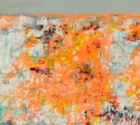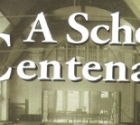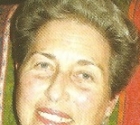-1403688425.jpg)
Some of the volunteers sifting the debris from Jerusalem’s Temple Mount
In memory of Anita Berman
This story is written in memory of my beloved grandmother, Anita Berman, who passed away three years ago. Her special virtues had much influence on me and consequently on the events that are related herewith.
.jpg)
Anita Berman...an inspiration
Anita was born in Durban, South Africa in 1919. In 1941 she married Eric Berman and in 1970 they made aliyah. After they moved to Raanana she became involved with volunteering for more than 20 years. She received two awards, one from ESRA and another from the Raanana Municipality.[1] During the late 90s, she became interested in archaeology, and occasionally shared her interest with me. Our conversations about archaeology and early Jewish history were in the background of our increasing interest in inquiring into our Jewish roots. Several years later I decided to start studying archaeology.
Archaeological Destruction on the Temple Mount
In November 1999, a large scale excavation took place on the Temple Mount in Jerusalem, by the Awaqf, the religious endowment which manages the site. This digging was done without any archaeological supervision or control, using heavy machinery and causing severe damage to ancient remains. The purpose was to create an entrance to Solomon’s Stables, a medieval period subterranean structure, which had been converted into a new mosque. About 400 truckloads of soil saturated with archaeological artifacts from all periods in the history of Jerusalem, were removed and dumped in various locations, mainly in the nearby Kidron Valley.
.jpg)
Earth from the Temple Mount illegally dumped in the Kidron Valley
These works were illicit and disregarded Israeli antiquities laws, which require a salvage excavation prior to any construction on an archaeological site. In a properly organized excavation, the exact location and context of artifacts are documented and the finds are removed with great care. When an archaeological site is excavated brutally with heavy machinery, disregarding the context and finds, major archaeological data is lost and can never be retrieved. However, out-of-context finds that are recovered from archaeological sites still preserve some valuable information. These finds, when studied thoroughly, can increase the information known about a site, especially if it hasn't previously been excavated. This is the case with the Temple Mount, where no systematic archaeological excavation has ever taken place. The Awaqf has always objected to archaeological research activity there, and this was a unique chance to have one before commencing construction.
.jpg)
1999: Heavy machinery used for digging a new entrance to Solomon’s Stables
At the time, I was a third year student of archaeology at Bar-Ilan University. Together with a fellow student, Aran Yardeni, and some other friends, we went over to the dump at the Kidron Valley and began surveying it, with the purpose of examining its archaeological value and hopefully saving some finds from it before they would all be completely mixed with other dumps. Our arrival at the site quickly triggered a visit from the Israeli Antiquities Authority inspectors who demanded that we hand over all the artifacts we had collected and leave the site immediately. We left the site with some artifacts hidden in our pockets and later on examined them with the help of our professors.
.jpg)
Silver half-shekel showing a stem with three pomegranates
We were invited to give a talk about the finds at a popular archaeological conference at the university. Our talk created a storm in which we got wide support from the archaeological community while the IAA officials accused us of being antiquities robbers. A week later, my home was raided by IAA inspectors accompanied by police and I was detained for investigation. A few months later the State pressed charges against me, accusing me of antiquities theft. The judge at the trial realized that the charges were political and dismissed the trial, asking the prosecution to retract their charges.
Following our actions we received lots of support from the public, and a special committee for the prevention of antiquities destruction on the Temple Mount was established. This committee has been active ever since, and even managed to get many major Israeli public figures from all political wings in Israel to sign a petition. The petition called for the Israeli Prime Minister to do whatever necessary to stop the antiquities destruction on the Temple Mount. In all of the history of Zionism, there has never been a document that has received such a wide consensus, despite the political sensitivity.
.jpg)
The enclosure containing the Temple Mount Antiquities Salvage Operation
Temple Mount Sifting Project
Following these events, Dr. Gabriel Barkay and I, decided to initiate a project for the systematic sifting of a sample of the dirt that was removed from the Temple Mount. There were many bureaucratic obstacles in our way, and it took us four years to receive an official permit from the Antiquities Authority. It also took some time to raise the funds needed to begin the project. We believed that the state should have taken responsibility for this atrocity and therefore fund the project, but the reality proved otherwise and the project finally began only after we received funds from the heritage foundation of Abraham and Frieda Wiener, the late parents of Fred Wiener, a New York state attorney who had coincidentally heard about our initiative and saw it as a worthy cause for this foundation.
.jpg)
Volunteers at the sifting installation at Emek Tzurim National Park
Eventually, in November 2004, the Temple Mount Sifting Project was established. For the purpose of this project, the National Parks Authority allocated a special site in the Emek Tzurim National Park, and special installations were set up to allow large groups of volunteers and visitors to sift the material using water.
From the beginning of the project it was evident that in order to retrieve valuable information from such a vast amount of material many volunteers would be needed, and indeed, many groups have offered their help. Maybe it is no coincidence that this kind of work could not be done by a small group of archaeologists and students. Rather, it is a responsibility, duty and privilege of the public to participate in this effort. This undertaking would not be a brief operation lasting only a few months, but a meaningful and sustained project continuing for many years. Therefore, after several months of operation, the Ir-David foundation adopted the project with the aim of sifting all of the debris and operating the project for many years. The project set an additional goal, and in addition to its original purpose, has become an educational tourist site for groups of volunteers from Israel and all over the world who come daily to participate in the sifting. To date more than 150,000 visitors have taken part in the sifting, which, in itself, is a unique phenomenon in the archaeological world.
This idea is movingly expressed in the Book of Psalms:
Thou wilt arise, and have compassion upon Zion; for it is time to redeem her, for the appointed time has come: For your servants have cherished her stones, and have redeemed her dust (Psalms 102: 14-15).
Every bucket that is sifted contains fragments of pottery and glass vessels, metal objects, bones, worked stones and mosaic tesserae stones. These are the most frequent finds in the Temple Mount soil, and items are dated mainly from the First Temple period (10th century BCE) until today. In addition to these general categories there are numerous finds of many kinds: fragments of stone vessels, pieces of jewelry made from a variety of materials, a rich assortment of beads, terracotta figurines, arrowheads and other weaponry, weights, items of clothing, game pieces and dice, bone and shell inlays, furniture decorations, ornaments, bone tools, etc. Fragments of elaborate architectural buildings from classical times are also numerous, and among them are pillars, architraves, mosaic floors, opus sectile tiles (see below), colored plastered walls (fresco), glazed wall tiles and more.
The prevalent finds are carefully sorted and studied in the project’s archaeological laboratory, and once the statistical analysis is completed, this data will provide fresh insights into the archaeological and historical research of the Temple Mount.
Occasionally, unique and invaluable finds are also recovered. Noteworthy is a clay sealing which has an impression preserved on it bearing the letters “...ליהו” (…LYHW) and “...אמר” (...AMR). It may be possible to complete the writing as "[להצ]ליהו/[בן] אִמֵר" (Belonging to Hatzalyahu son of Immer). The house of Immer was a well-known priestly family at the end of the First Temple period, roughly from around the 7th – 6th Centuries BCE, and the days of Return to Zion. Pashur, son of Immer, is said to be “Chief Officer in the house of God.” (Jer. 20:1)
The impression on the back of the sealing indicates that it was originally attached to a fabric parcel or a sack, and it may be assumed that it sealed some precious goods that were kept in the Temple treasury which was managed by the priests. This sealing is the first ever evidence of ancient Hebrew writing from the Temple Mount and to the administrative activity which took place in the First Temple.
To date, the Sifting Project has uncovered more than 5000 coins, ranging from tiny silver Persian period coins (4th century BCE) until modern times. These coins that were found in the rubble testify to the rich past of the Temple Mount. An extremely rare silver coin, which aroused great excitement when it was discovered, was also minted during the Great Revolt against the Romans (66/67 CE). The face of the coin features a branch of three pomegranates and an inscription in ancient Hebrew “holy Jerusalem” (“ירושלים הקדושה”). The reverse side of the coin features an omer (ancient unit of measure) cup with the writing: “half shekel” (“חצי השקל”). Half-shekel coins were used to pay the Temple tax during the period of the Great Revolt, and replaced the Tyrian shekel which was used for this purpose earlier. It appears that these coins were minted on the Temple Mount itself by the Temple authorities. The half-shekel tax for the Temple, mentioned in the Book of Exodus (30:13-15), required every male to pay half a shekel to the Temple every year. The coin was well preserved, although it bears scars from a fire, which may have been the conflagration that caused the destruction of the Second Temple in 70 AD. This is the first time that this type of coin, originating from the Temple Mount itself, has been found.
Another discovery from the Second Temple period consists of a large number of floor tiles in a variety of shapes and colors, which were assembled together to form rich geometric patterns. This paving technique is known in the Roman world as opus sectile. Some of the tiles are dated according to parallels found in Herodian palaces. Their sizes are based on the Roman foot (c. 29.6 cm) and are associated with the “Golden Ratio.” The writings of Josephus Flavius testify to the fact that this technique was used as ornamentation for the Temple Mount in open courts which surrounded the Temple: “Those entire courts that were exposed to the sky were laid with stones of all sorts and colors.” (The Jewish War 5.5.2) This description is now finally understood thanks to these finds. Other opus sectile tiles found in the sifting are dated to later periods. The variety of sizes, shapes, colors and materials of tiles and the wide range of comparative dates point to the enduring popularity of opus sectile tiles in structures on the Temple Mount.
The Sifting Project has proven to be an inexhaustible source of knowledge for the research and study of the archaeology and history of the Temple Mount. To date, less than half of the debris removed from the Mount has been sifted. The project is continuing full steam ahead and many more finds are waiting to be discovered by volunteers who come to work at the site.
.jpg)
Sealing from the 7th centuries BCE
Back to Anita Berman
As mentioned previously, Anita was a person who dedicated herself to volunteering and taking upon herself responsibility to fulfill society's needs when the state does not take action. These virtues are in fact the essence of the Temple Mount Sifting Project, which is all about the spirit of volunteering, taking action with no self-interest, and taking responsibility in public matters instead of just blaming the state. Both of my grandparents, Anita and Eric, were characterized by great honesty and gave much value to seeking the truth in every aspect of life. The Sifting Project is all about inquiring into our heritage by examining small details that sometimes seem meaningless. It is a process of sorting and inquiry: separating the archaeological finds from the natural stones, sorting the finds according to their materials, after which the professional archaeologists continue this process by dating the finds and classifying them by function and type.
The final process is quantifying the finds according to their distribution among the different sections of the dumps.
.jpg)
Floor tiles of various shapes, colors and sizes that were used in the opus sectile Roman paving technique in royal structures. This type of floor is mentioned in the writings of Josephus Flavius regarding the floor of the open courts that surrounded the Temple
Eventually, when the whole puzzle is assembled, the final result is a new point of view on the history of the Temple Mount and Jerusalem, a point of view that might lead to valuable insights about the history of the site and our heritage. This process is exactly what Anita pursued in her life when she paid so much attention to details, whether they were the accountancy details in her job in South Africa helping Russian immigrants find apartments or matching volunteers to appropriate tasks, but mainly in her great interest in archaeological discoveries. In our first archaeological discussions, I did not really understand the significance of the finds she was discussing with me, but today I do.
For more details about the Temple Mount Sifting Project and how to participate, visit: templemount.wordpress.com
Facebook: Temple Mount Sifting Project
Acknowledgment: I am grateful to my mother Hilla Zweig, daughter of Anita, for helping me in writing and editing this article. Sadly, she passed way a short time after it was completed (July 2013). Yehi Zichra Baruch.
[1] For more details about her volunteering history see article in ESRA Magazine, issue 161.
 Abstracts – Old and New: Steffa Reis Exhibition
Abstracts – Old and New: Steffa Reis Exhibition Advertisers Directory 175
Advertisers Directory 175 Milestones 175
Milestones 175 A School Centenary
A School Centenary Train Trips
Train Trips-1451900978.jpg) The Agunah- The Deserted Wife
The Agunah- The Deserted Wife-1400675051.jpg) Zachi Dvira (Zweig)
Zachi Dvira (Zweig)